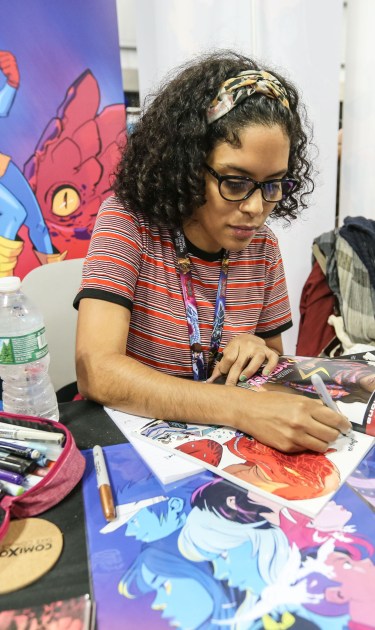In 2014, comics historian and researcher Tim Hanley summed up the lack of diversity among comics creators with two stats: 1. Men outnumber women 9 to 1 at both DC and Marvel. 2. 79 percent of those who worked on comics in 2014 were white. FiveThirtyEight fairly acknowledges that changes are taking place and that Marvel and DC are actively looking to add more diversity to their teams. But we still have a long way to go until minorities and women have accurate representation.
Walking through New York Comic Con this gap was glaringly clear. However, in a very packed Artist’s Alley, there were plenty of artists who broke the mold. I spoke to three female artists – all in different stages of their careers – who paint an optimistic picture of what the future of the industry will bring for women of color. Meet them below:
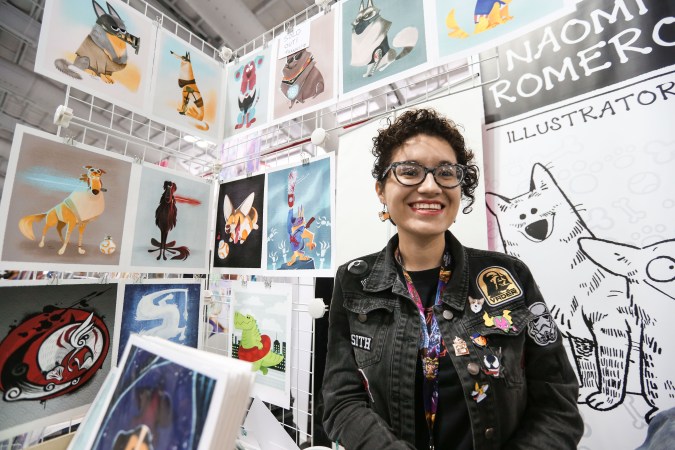
Naomi Romero, Illustrator and Animator
She may be on the verge of turning 25, but Naomi Romero’s work has already become an internet sensation. More than a year ago, she decided to create a corgi plush toy. She started a crowdfunding campaign on IndieGoGo to make it possible. After 60 days, she very well expected to put in her own money to meet the $6,512 goal. Instead, people pitched in and blew way past that number in less than 24 hours. After the high demand, she created a Shiba Inu plush that sold out even more quickly – in something like 11 hours, she recalls. Romero plans to add a dog to the collection every year, but she doesn’t want to create toys for a living. Instead, she wants to keep drawing her dog-centric prints – adorable mash ups of dogs and pop culture icons – and working in animation. She’s just now getting started in comic books, which are of course, dog-themed.
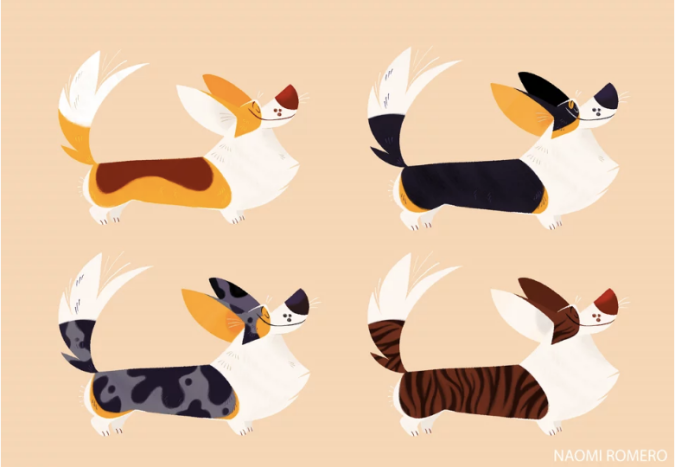
Romero didn’t attend art school because she couldn’t afford it. And though she loved to draw her entire life, she began studying criminology. Eventually, she dropped out to pursue her dream. Naomi said she finally found her point of view at age 22, and she hasn’t looked back since.
She’s linked with other artists of color – something she stresses is key in this industry – and has found a support system. “It’s sad how we’re definitely out there, but people don’t care because we’re just that little fish in a big sea of white artists,” she told me. “Nobody notices us because we’re just so far in between like all the other artists already in the industry. But I think we’re heading in the right direction.”

Natacha Bustos, Artist for Moon Girl and Devil Dinosaur
About a year ago, io9 called Moon Girl and Devil Dinosaur “one of Marvel’s biggest (and cutest) new comics.” The Devil Dinosaur comic book originally debuted in 1978 and had a male protagonist. But when writers Brandon Montclare and Amy Reeder updated the plot in a modern-day setting, they decided that the main character should now be Lunella Lafayette, aka Moongirl. Montclare and Reeder knew they wanted Natacha Bustos to illustrate it. The little girl they pictured as the star of the series even looked like Bustos as a child – something she easily provides proof of with her phone.
While at this point in her career, people like Montclare and Reeder may have “begged her” to work with them, breaking into the business took a lot of hustle for the Spanish-born artist of Chilean and Brazilian descent. The reason Moon Girl is so important to her is because she didn’t have that sort of role model as a child. “It’s significant to obviously to have a little girl like Lunella, who is African-American and isn’t always seen in comics,” she said. “When I was growing up, I didn’t have a reference point. The only person like that was Storm in X-Men, and I was like ‘Wow, I love Storm!’ But that was it. There weren’t a lot of women, either.”
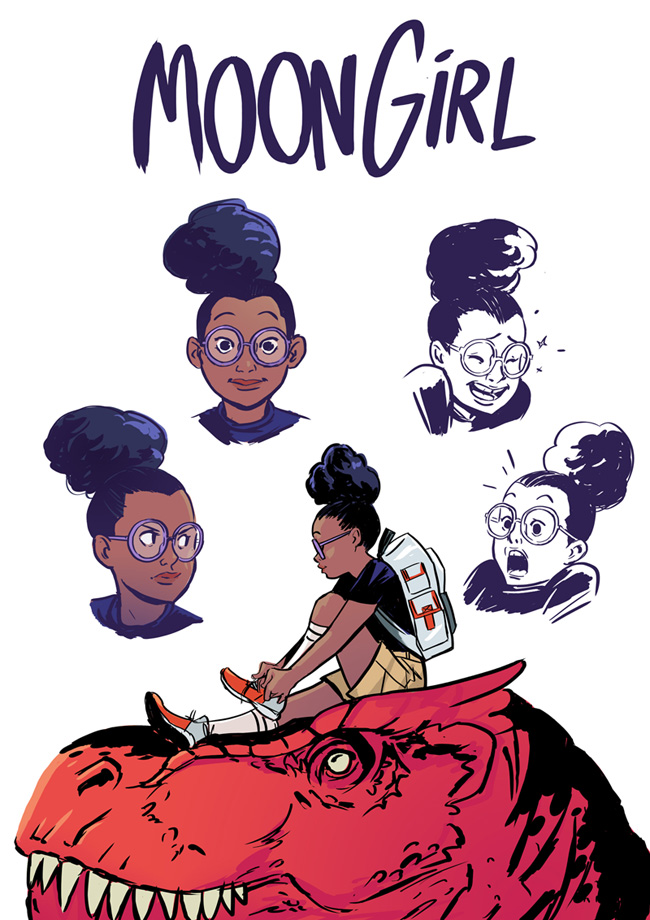
But the internet makes it easier for girls and young women to find their heroes. It may not be mainstream, but someone is out there creating this kind of work. Bustos encourages young people of color trying to break into comics to take full advantage of the internet. They can use it as a tool to publish their own work and to network. Though she doesn’t believe anyone needs to study art to make it in this industry, she does think people have to come in with an open mind and be willing to put themselves out there.
For her, the art world hasn’t been unwelcoming, but she does notice a pattern when she attends panels and conventions. “There’s a lot of artists and they’re all men,” she said. “In Spain, the exact same thing happens. In Spain, there’s a collective of women authors (Colectivo de Autoras de Comics) – of which I’m a part of – that fight over gender injustices. For example, there was a convention in Spain that had a talk about women, but all the panelists were men, so we stepped in and said if you really want to talk about these issues correctly, contact us ahead of time and we can organize something together and do it right. It’s trendy to talk about women, but it’s not a trendy thing. We need to fight, so it’s about real change.”
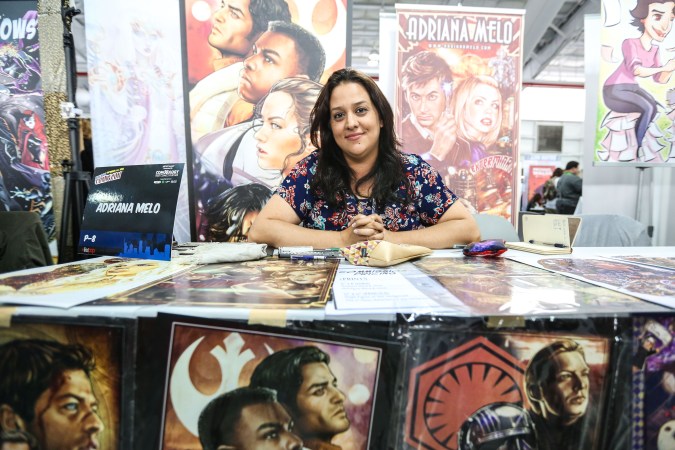
Adriana Melo, Comic Book Artist for Titan Comics
With her Doctor Who and Game of Thrones posters up on display, there was no way Adriana Melo wasn’t going to draw a crowd. Her impeccable work speaks for itself. But those who know of her, know she’s a highly accomplished comic book artist and penciller behind several Star Wars and Star Wars: Empire titles.
Melo’s loved drawing since childhood; she first started flexing her artistic muscles by copying what she saw inside the pages of fashion magazines. In her youth, she attended a small convention in Brazil – where she still lives – and managed to impress two Marvel comic book artists, even though she felt unsure about her work at that point. Even then, she was the only woman among 30 to 40 men vying for this position.
Luckily for Melo, she always felt welcomed in this male-dominated space, and people really took the time to mentor her and help her learn about every aspect of how to make a comic book. But she knows she’s an anomaly. “I never heard from them like jokes, or I never felt they doubt me,” she told me. “Of course, they were surprised that a girl would like to do draw that kind of thing, especially in Brazil 20 years ago. It was unheard of, especially from fans that buy comic books.”
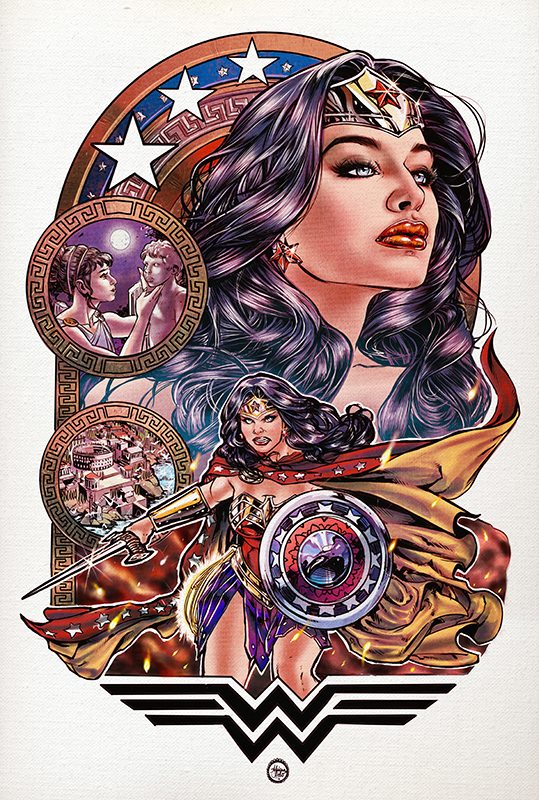
Her talent’s never been an issue for her or for those buying her work. But sexist behavior permeated in other ways. Her colleagues don’t have to worry about looking like the characters they draw.
“People tend to talk about a girl working in comic books like she should look like what she’s drawing, and I never saw any guy saying the same thing about the guys that are drawing,” she said. “I never heard any one say well that guy doesn’t look like Superman, that guy doesn’t look like Batman. But a lot of readers think that if you draw, if you paint, if you work in comic books, you have to look like Wonder Woman.”
And though this brings unfair pressure to her, Melo’s also in the position to inspire the next generation of women. Young girls regularly send her messages asking her for advice about breaking into comics. “It’s amazing,” she concludes.
